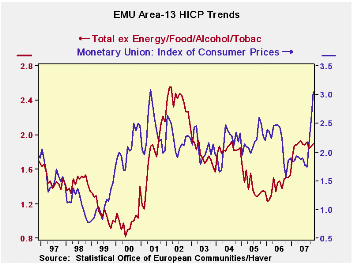 Global| Dec 14 2007
Global| Dec 14 2007EMU Inflation Surges as Core Dallies Over Top-Allowed Pace
Summary
The inflation trends tell the story. It’s a clear story of angst at the ECB. The sequential growth rates (3Mo Vs 6Mo Vs 12Mo) show a steady quickening of the pace of inflation in the more recent time periods. Over 12 months (ECB’s [...]

The inflation trends tell the story. It’s a clear story of
angst at the ECB. The sequential growth rates (3Mo Vs 6Mo Vs 12Mo) show
a steady quickening of the pace of inflation in the more recent time
periods. Over 12 months (ECB’s preferred horizon) three of our four key
EMU countries show ex food ex energy and ex alcohol inflation at a pace
above the ECB ceiling. Over the more recent periods that situation has
only gotten worse. As to headline inflation: forget about it. The
history on the graph on the let shows that once headline inflation
spurts the core rise usually follows in a year or so. The year 2005 was
an exception when the core fell by itself. There is nothing automatic
about headline-> core inflation transmission. But there is
enough correlation to make the ECB’s fears of second or third round
effects real. On top of that the current core pace is simply
unacceptable.
If the multi-central bank dollar credit facility is
‘successful’ it could hasten the time when the ECB hikes rates. Whether
that widens interest differentials with the US depends on whether US
circumstances normalize and whether such normalization brings with it a
rebalancing of the economy (where consumer confidence is sagging so
badly and in a way that it does not appear to be wholly determined by
credit market issues).
While the credit turmoil, crisis, scam or whatever you may
want to call it, is a real and essentially global phenomenon, it is not
the only concern in town. And that applies to the evolution of European
growth as well as in the US. In Europe arguably much of the outlook
hangs in the balance on what the euro does from here on out. What
inflation does and how the ECB responds to it will be a large par of
that.
| Trends in HICP | |||||||
|---|---|---|---|---|---|---|---|
| % mo/mo | % saar | ||||||
| Nov-07 | Oct-07 | Sep-07 | 3-Mo | 6-Mo | 12-Mo | Yr Ago | |
| EMU-13 | 0.7% | 0.4% | 0.4% | 6.1% | 3.7% | 3.1% | 1.9% |
| Core | 0.3% | 0.3% | 0.2% | 3.4% | 2.5% | 2.3% | 1.6% |
| Goods | 1.0% | 0.8% | 1.0% | 11.8% | 3.7% | 3.4% | 1.7% |
| Services | -0.1% | 0.0% | -0.5% | -2.4% | 1.2% | 2.5% | 2.1% |
| HICP | |||||||
| Germany | 0.9% | 0.2% | 0.7% | 7.1% | 4.1% | 3.3% | 1.5% |
| France | 0.8% | 0.2% | 0.1% | 4.6% | 3.4% | 2.6% | 1.6% |
| Italy | 0.3% | 0.7% | 0.3% | 5.1% | 3.3% | 2.5% | 2.1% |
| Spain | 0.8% | 0.7% | 0.4% | 7.4% | 4.7% | 4.1% | 2.7% |
| Core Excl Food Energy & Alcohol | |||||||
| Germany | 0.4% | 0.2% | 0.3% | 3.5% | 2.5% | 2.4% | 1.1% |
| France | 0.3% | 0.2% | 0.1% | 2.6% | 2.3% | 1.9% | 1.4% |
| Italy | 0.2% | 0.5% | 0.4% | 4.3% | 2.7% | 2.2% | 1.8% |
| Spain | 0.3% | 0.7% | 0.2% | 4.9% | 3.9% | 3.3% | 2.7% |
Robert Brusca
AuthorMore in Author Profile »Robert A. Brusca is Chief Economist of Fact and Opinion Economics, a consulting firm he founded in Manhattan. He has been an economist on Wall Street for over 25 years. He has visited central banking and large institutional clients in over 30 countries in his career as an economist. Mr. Brusca was a Divisional Research Chief at the Federal Reserve Bank of NY (Chief of the International Financial markets Division), a Fed Watcher at Irving Trust and Chief Economist at Nikko Securities International. He is widely quoted and appears in various media. Mr. Brusca holds an MA and Ph.D. in economics from Michigan State University and a BA in Economics from the University of Michigan. His research pursues his strong interests in non aligned policy economics as well as international economics. FAO Economics’ research targets investors to assist them in making better investment decisions in stocks, bonds and in a variety of international assets. The company does not manage money and has no conflicts in giving economic advice.






